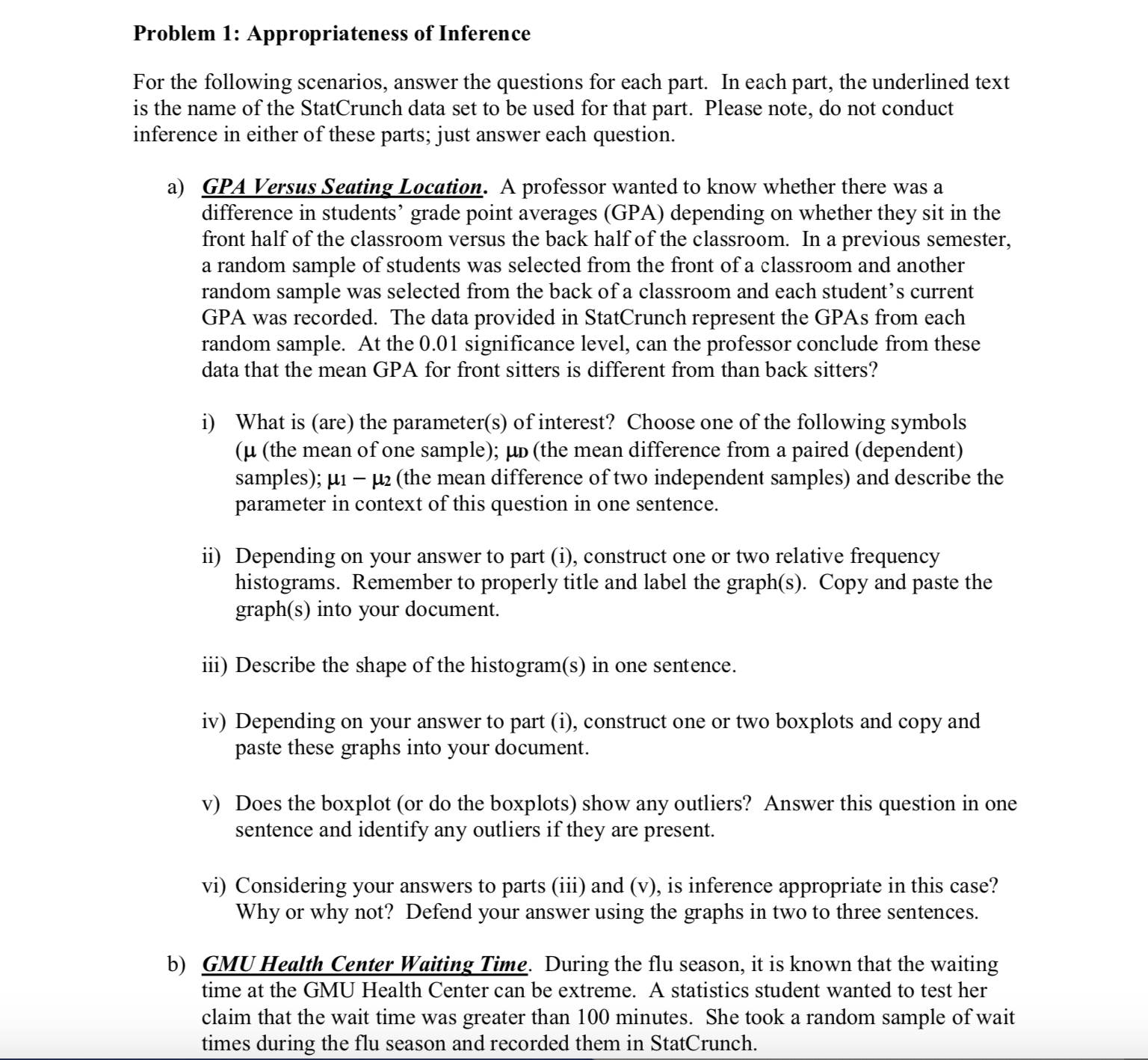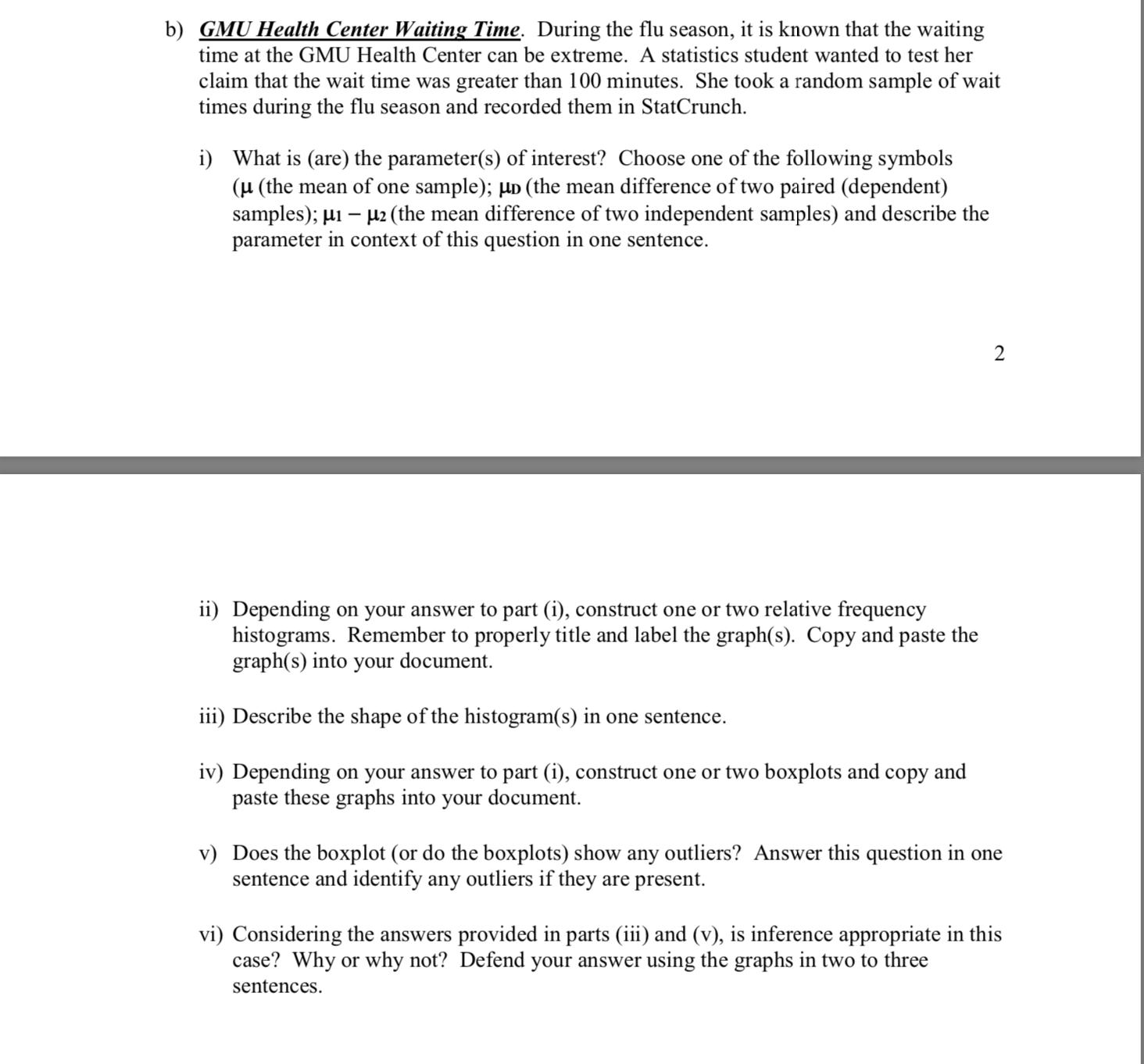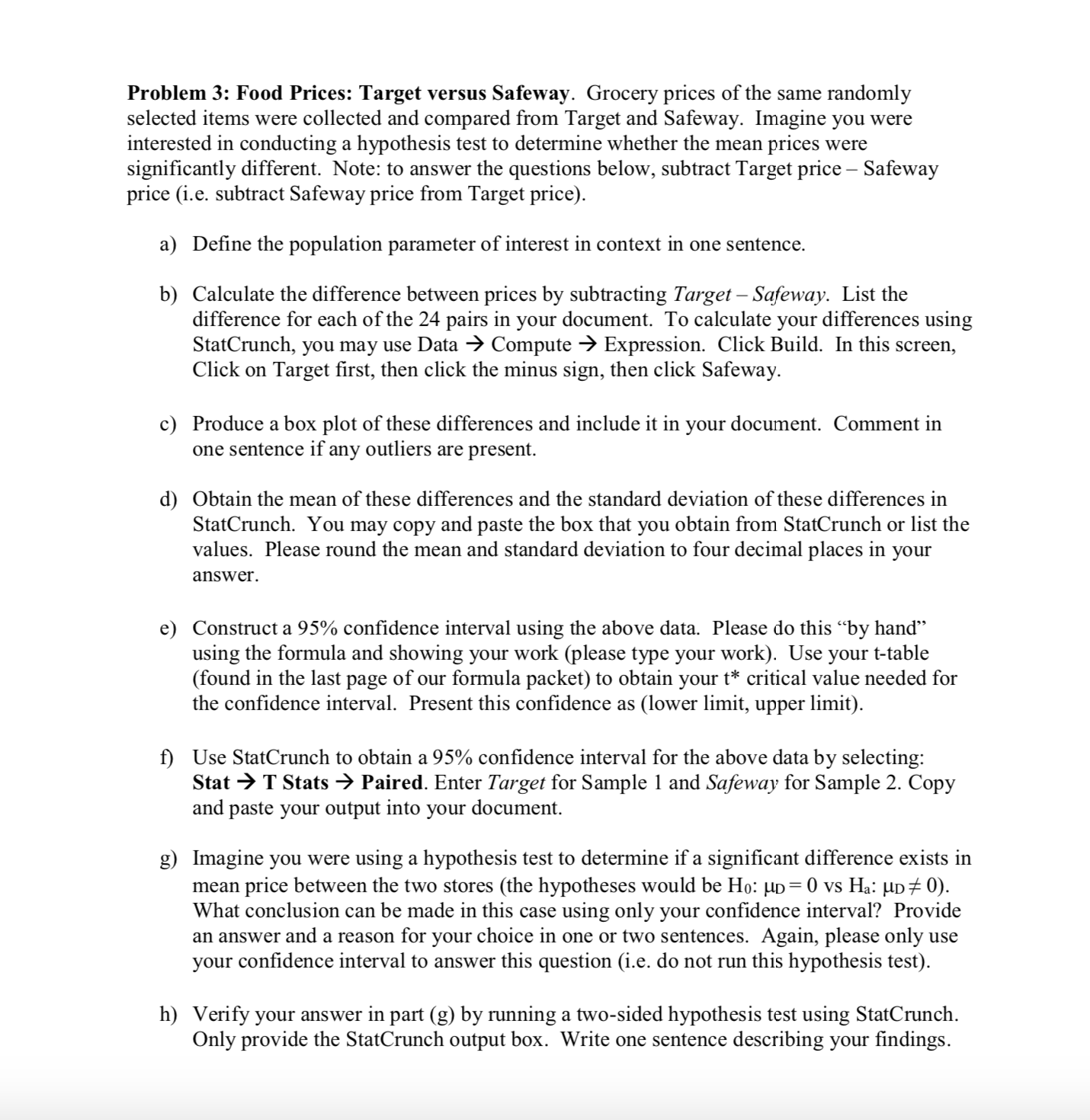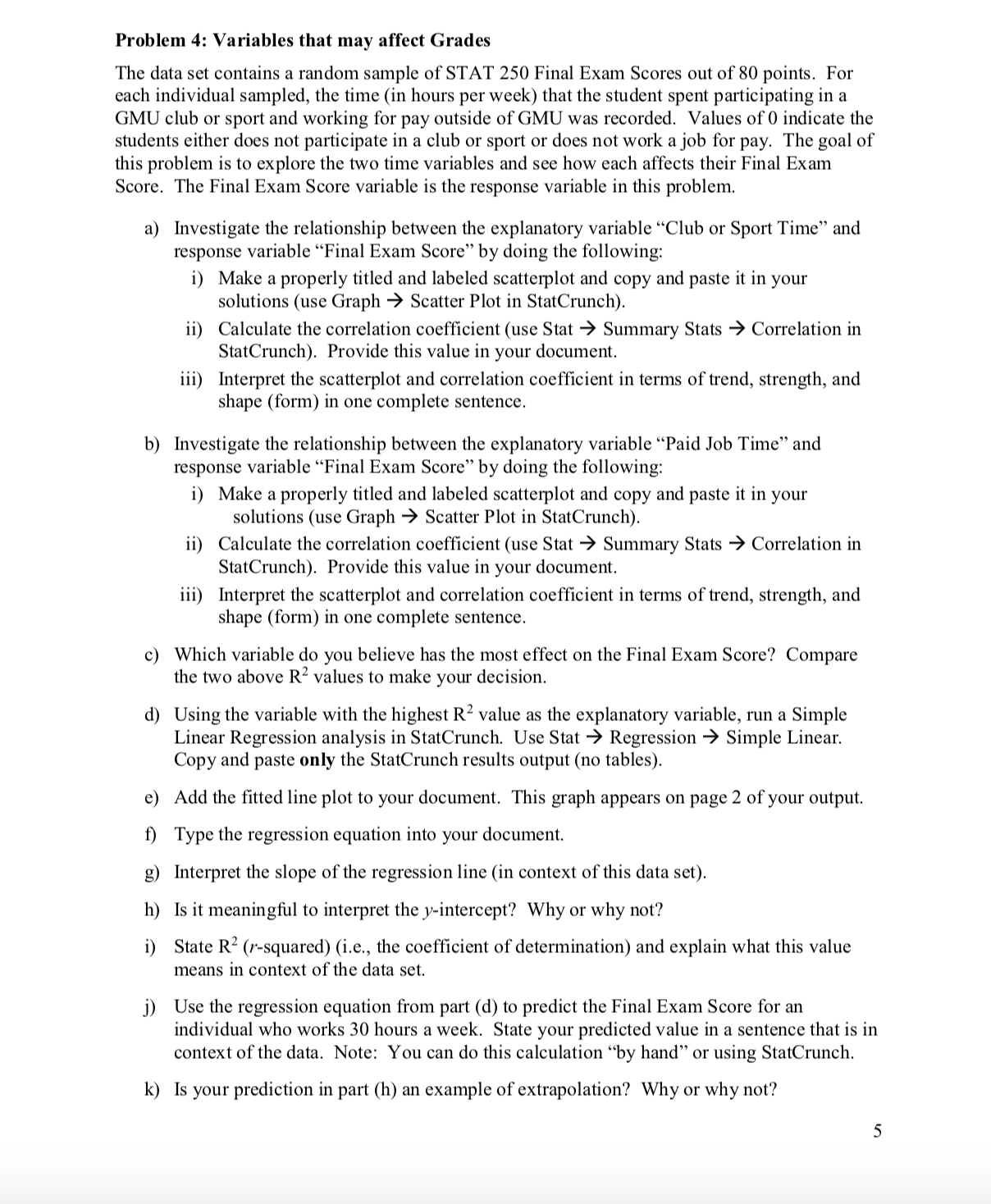Hello, I need help with these stat problems please
Problem 1: Appropriateness of Inference For the following scenarios, answer the questions for each part. In each part, the underlined text is the name of the StatCrunch data set to be used for that part. Please note, do not conduct inference in either of these parts; just answer each question. a) b) GPA Versus Seating Location. A professor wanted to know whether there was a difference in students' grade point averages (GPA) depending on whether they sit in the front half of the classroom versus the back half of the classroom. In a previous semester, a random sample of students was selected from the front of a classroom and another random sample was selected from the back of a classroom and each student's current GPA was recorded. The data provided in StatCrunch represent the GPAs from each random sample. At the 0.01 signicance level, can the professor conclude from these data that the mean GPA for front sitters is different from than back sitters? i) What is (are) the parameter(s) of interest? Choose one of the following symbols (p. (the mean of one sample); pm (the mean difference from a paired (dependent) samples); |.I.1 [12 (the mean difference of two independent samples) and describe the parameter in context of this question in one sentence. ii) Depending on your answer to part (i), construct one or two relative 'equency histograms. Remember to properly title and label the graph(s). Copy and paste the graph(s) into your document. iii) Describe the shape of the histograrn(s) in one sentence. iv) Depending on your answer to part (i), construct one or two boxplots and copy and paste these graphs into your document. v) Does the boxplot (or do the boxplots) show any outliers? Answer this question in one sentence and identify any outliers if they are present. vi) Considering your answers to parts (iii) and (v), is inference appropriate in this case? Why or why not? Defend your answer using the graphs in two to three sentences. GMU Health Center Waiting Time. During the u season, it is known that the waiting time at the GMU Health Center can be extreme. A statistics student wanted to test her claim that the wait time was greater than 100 minutes. She took a random sample of wait times during the u season and recorded them in StatCrunch. b) GMU Health Center Waiting Time. During the flu season, it is known that the waiting time at the GMU Health Center can be extreme. A statistics student wanted to test her claim that the wait time was greater than 100 minutes. She took a random sample of wait times during the flu season and recorded them in StatCrunch. i) What is (are) the parameter(s) of interest? Choose one of the following symbols ('4 (the mean of one sample); no (the mean difference of two paired (dependent) samples); pl - 11.2 (the mean difference of two independent samples) and describe the parameter in context of this question in one sentence. ii) Depending on your answer to part (i), construct one or two relative frequency histograms. Remember to properly title and label the graph(s). Copy and paste the graph(s) into your document. iii) Describe the shape of the histogram(s) in one sentence. iv) Depending on your answer to part (i), construct one or two boxplots and copy and paste these graphs into your document. v) Does the boxplot (or do the boxplots) show any outliers? Answer this question in one sentence and identify any outliers if they are present. vi) Considering the answers provided in parts (iii) and (v), is inference appropriate in this case? Why or why not? Defend your answer using the graphs in two to three sentences. Problem 2: Pizza Prices in Different Cities ( no data set in Stat Crunch ) A food blogger is interested in comparing the price of pizzas available for purchase in New York City to those available in Washington , D. C . To do so , they collected a random sample of 30 large cheese pizzas from each of the cities . The New York pizzas had an average price of $ 1 2. 83 with a standard deviation of $4 . 45 . The Washington , D. C . pizzas had an average price of $10 . 71 with a standard deviation of $3. 74 . At the 0. 01 significance level , can the blogger conclude that the mean price of a large cheese pizza in New York is higher than Washington , D. C. ? Assume* all conditions for conducting inference are satisfied . a ) Conduct a full hypothesis test by following the steps below . Enter an answer for each of these steps in your document . i . Define the population parameter of interest in context of this question in one* sentence . 11 . State the null and alternative hypotheses using correct notation . ini . State the significance level for this problem ." IV . Calculate the test statistic in Stat Crunch using STAT > T Stats > 2 Sample > With Summary . Copy and paste the output table into your document ." V . Label the p - value seen in your output table produced in part ( iv ) using the proper probability notation ( it begins with P ( ... ) ) .\\ VI .` State whether you reject or do not reject the null hypothesis and your reason for your answer in one sentence .* Vil . State your conclusion in context of the problem ( i.e . interpret your results and / or* answer the question being posed ) in one or two complete sentences . b ) Imagine if the significance level for this problem was 0. 05 . State your decision and conclusion for the above hypothesis test when you compare your p-value found in part ( V ) with the significance level of 0 . 05 . 3Problem 3: Food Prices: Target versus Safeway. Grocery prices of the same randomly selected items were collected and compared from Target and Safeway. Imagine you were interested in conducting a hypothesis test to determine whether the mean prices were signicantly different. Note: to answer the questions below, subtract Target price Safeway price (i.e. subtract Safeway price from Target price). a) Dene the population parameter of interest in context in one sentence. b) Calculate the difference between prices by subtracting Target Safeway. List the difference for each of the 24 pairs in your document. To calculate your differences using StatCrunch, you may use Data 9 Compute 9 Expression. Click Build. In this screen, Click on Target rst, then click the minus sign, then click Safeway. c) Produce a box plot of these differences and include it in your document. Comment in one sentence if any outliers are present. (1) Obtain the mean of these differences and the standard deviation of these differences in StatCrunch. You may copy and paste the box that you obtain from StatCrunch or list the values. Please round the mean and standard deviation to four decimal places in your answer. e) Construct a 95% condence interval using the above data. Please do this \"by hand\" using the formula and showing your work (please type your work). Use your t-table (found in the last page of our formula packet) to obtain your t* critical value needed for the condence interval. Present this condence as (lower limit, upper limit). f) Use StatCrunch to obtain a 95% condence interval for the above data by selecting: Stat 9 T Stats 9 Paired. Enter Target for Sample 1 and Safeway for Sample 2. Copy and paste your output into your document. g) Imagine you were using a hypothesis test to determine if a signicant difference exists in mean price between the two stores (the hypotheses would be Ho: |.l.[) = 0 vs Ha: up 95 0). What conclusion can be made in this case using only your condence interval? Provide an answer and a reason for your choice in one or two sentences. Again, please only use your condence interval to answer this question (i.e. do not run this hypothesis test). h) Verify your answer in part (g) by running a two-sided hypothesis test using StatCrunch. Only provide the StatCrunch output box. Write one sentence describing your ndings. Problem 4: Variables that may affect Grades The data set contains a random sample of STAT 250 Final Exam Scores out of 80 points . For each individual sampled , the time ( in hours per week ) that the student spent participating in a GMU club or sport and working for pay outside of GMU was recorded . Values of'0 indicate the* students either does not participate in a club or sport or does not work a job for pay . The goal of this problem is to explore the two time variables and see how each affects their Final Exam* Score . The Final Exam Score variable is the response variable in this problem ." a) Investigate the relationship between the explanatory variable " Club or Sport Time " and response variable " Final Exam Score " by doing the following ." 1 ) Make a properly titled and labeled scatterplot and copy and paste it in your* solutions ( use Graph > Scatter Plot in Stat Crunch ) ." ii ) Calculate the correlation coefficient ( use Stat > Summary Stats > Correlation in Stat Crunch ) . Provide this value in your document ." iii ) Interpret the scatterplot and correlation coefficient in terms of trend , strength , and shape ( form ) in one complete sentence .* b ) Investigate the relationship between the explanatory variable " Paid Job Time " and* response variable " Final Exam Score " by doing the following ." 1 ) Make a properly titled and labeled scatterplot and copy and paste it in your * solutions ( use Graph > Scatter Plot in Stat Crunch ) .* ii ) C Calculate the correlation coefficient ( use Stat > Summary Stats > Correlation in Stat Crunch ) . Provide this value in your document . iii ) Interpret the scatterplot and correlation coefficient in terms of trend , strength , and shape ( form ) in one complete sentence . C ) Which variable do you believe has the most effect on the Final Exam Score ? Compare* the two above R_ values to make your decision ." d) Using the variable with the highest R _ value as the explanatory variable , run a Simple Linear Regression analysis in StatCrunch . Use Stat > Regression > Simple Linear .* Copy and paste only the Stat Crunch results output ( no tables ) . @ ) Add the fitted line plot to your document . This graph appears on page 2 of your output . 1) Type the regression equation into your document . 8) Interpret the slope of the regression line ( in context of this data set ) h) Is it meaningful to interpret the y - intercept ? Why or why not ? 1 ) State R = ( r - squared ) ( i.e . , the coefficient of determination ) and explain what this value means in context of the data set ." j) Use the regression equation from part ( d ) to predict the Final Exam Score for an individual who works 30 hours a week . State your predicted value in a sentence that is in context of the data . Note : You can do this calculation " by hand " or using StatCrunch . K) Is your prediction in part ( h ) an example of extrapolation ? Why or why not ? 5











